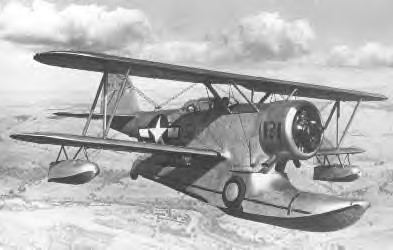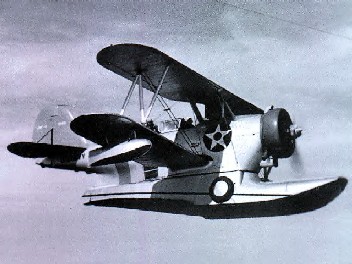The Duck originated with designs and production aircraft made by Loening Aeronautical Engineering Corporation. When Loening was taken over by Curtiss-Wright in 1929, several key employees of the former Loening Aeronautical (among them; Leroy Grumman) formed the Grumman Aircraft Engineering Corporation which was financed by Grover Loening. In 1928, even before Curtiss-Wright took over Grover Loening Aeronautical Engineering, Loening formed the Grover Loening Aircraft Company. In 1931, Grover Loening Aircraft submitted their XO2L-1 design to the U.S. Navy for its new "Utility" category. The Navy was intrigued with the design, but as Loening had no production facilities, he was directed to Grumman. Grumman accepted the craft as "Design 7". After modifications to make it more easily produced, Grumman submitted the specifications to the Navy in 1932 and the Navy accepted it as the XJF-1.
A glance at the Loening "Air Yacht" (produced during the 1920s) reveals a somewhat more than casual resemblance to the Duck and the Navy had been aware of the craft since its inception. This and the fact Loening had a sterling reputation as a designer, made acceptance a foregone conclusion.
On Tuesday, April 25, 1933, the XJF-1 flew for the first time. Pilot Paul Hovgaard, took off from a grass strip in front of the Grumman factory at Farmingdale, NY. The Duck was classified as a "single bay" bi-winger, meaning there was only a single set of struts outboard of the fuselage and a single set of bracing wires between the upper and lower wings on each side. Power for the XJF-1 and the JF-1 came from a 14 cylinder Pratt & Whitney R-1830-62 "Twin Wasp" engine of 700 hp (522.4 kW) and a Hamilton Standard three blade prop. To keep it afloat, a single large float was mounted under the centerline of the craft. Faired flush into the sides of the main float was the main landing gear which could be raised and lowered by a system of motors, sprockets, chains and gears. A small outrigger float was mounted near the tip of each wing. The crew consisted of a pilot and rear gunner under the telescoping canopy. There were also provisions for two passengers located just aft of the lower wing in the main float.
 Grumman delivered the XJF-1 to the NAS Anacostia on May 4, 1933 for testing and evaluation. The only modification recommended was a very minor change in the shape of the tail surfaces. The originals were triangular in shape and the Navy felt horizontal and vertical control could be improved by adding more area to the surfaces. Grumman changed the rudder and elevators to a more rectangular shape and redelivered the XJF-1 to the Navy in early 1934 where it was again accepted for evaluation. It was sent immediately to the Naval Test Unit at NAS Norfolk, VA. This aircraft (Serial Number 9218) crashed in the James river near Norfolk, VA on March 8, 1934 while being tested by the Navy. The cause was thought to have been pilot error.
Grumman delivered the XJF-1 to the NAS Anacostia on May 4, 1933 for testing and evaluation. The only modification recommended was a very minor change in the shape of the tail surfaces. The originals were triangular in shape and the Navy felt horizontal and vertical control could be improved by adding more area to the surfaces. Grumman changed the rudder and elevators to a more rectangular shape and redelivered the XJF-1 to the Navy in early 1934 where it was again accepted for evaluation. It was sent immediately to the Naval Test Unit at NAS Norfolk, VA. This aircraft (Serial Number 9218) crashed in the James river near Norfolk, VA on March 8, 1934 while being tested by the Navy. The cause was thought to have been pilot error.
Shortly after, the Navy ordered 27 JF-1s and the first Ducks were delivered beginning in May, 1934 to Norfolk NAS. These had provisions for mounting a machine gun at the rear seat facing aft. In addition, a single bomb rack was mounted under each wing, capable of carrying a 100 lb (45.4 kg) bomb or depth charge on each. The JF-1 had the same Pratt & Whitney R-1830-62 engine as the prototype. The main float was also a Grumman design (Grumman Model "A") and like the prototype, it included retractable main landing gear, making the Duck a true amphibian. In addition to being able to operate from land or water, the JF-1 came complete with a tail-hook for operation from a carrier deck. The JF-1 Duck was an extremely rugged aircraft (as were all Ducks). For example, on December 7, 1937 Marine Sergeant Bernard Belcher flipped his aircraft completely upside down while trying to land in a cross-wind (a particularly hazardous undertaking in a Duck). And, though the JF-1 dug its nose into the ground and somersaulted, the only damage sustained was a few wrinkles in the top of the rudder and fin. Sergeant Belcher was uninjured.
Though the JF-2 looked very similar to the JF-1, there were subtle differences, the most obvious being the installation of a loop radio direction finding antenna to the rear of the canopy. This antenna was removed whenever the Browning .30 caliber machine gun was mounted so as not to interfere with the field of fire. A somewhat less noticeable difference was the change to a Wright 1820 "Cyclone" engine which resulted in a much narrower chord for the engine cowling. Horsepower was the same as the Pratt-Whitney, and the reason for the change is somewhat obscure. In all probability the Wright engine was more readily available at the time. The Duck set a world speed record for single engine amphibians on Wednesday, December 4, 1935 when a JF-2 (Serial #0266) was flown near Quantico, VA at a speed of 191 mph (307.39 kph). A total of 14 JF-2s were built. The JF-2 Duck was built exclusively for the Coast Guard, and thus the tail hook of the JF-1 was deleted. Most of the JF-2s were later transferred to the Navy and Marines.
The JF-3 had provisions for both the direction finder loop antenna and the Browning machine gun by simply mounting the antenna under the canopy between the pilot and rear gunner/observer. As with the JF-2, the tail hook was omitted in the JF-3 Duck, as it was built for the Navy and Marine Corps Reserve units. Only 5 JF-3s were built The JF-3 Duck was the last of the JF series with production ending in October 1935.
The J2F series was first ordered in March 1936. The J2F-1 Duck first flew on Friday, April 3, 1936 and was delivered to the Navy that same afternoon. And although it was still the basic JF Duck, many improvements were incorporated into the new Grumman Design #15, starting with a new Wright 1820 Cyclone of 750 hp (559.5 kW). It was decided to make this "Utility" craft even more so. The tail hook was installed again, along with provisions for a heavier bomb load and a stretcher in the lower passenger compartment to carry wounded. It was also fitted with smoke laying and target towing gear. It could be used for a photo or reconnaissance missions as well as itís normal function as a small transport. The main float was extended forward 12 inches. A total of 29 J2F-1s were built by April 1937 to complete the production run.
July of 1941 saw the most abundant and also the last of the Grumman built Ducks, the J2F-5. Power of the Wright 1820 Cyclone had by this time been raised to 950 hp (708.7 kW). Since the oil coolers had been repositioned to the engine compartment, the Duck returned to the broad chord engine cowling of the Pratt-Whitney. Other small modifications were made to increase bomb load and to facilitate easier loading of the craft. A hundred forty-four J2F5s were built
When the last J2F-5 rolled off the assembly line, Grumman went to work on other more important aircraft which were desperately needed in the first months following the Japanese attack on Pearl Harbor. The J2F Duck project was shifted to the Columbia Aircraft Corporation who built the J2F-6 at their Valley Stream, Long Island factory from early 1942 to the end of WWII. The J2F-6 was identical to the -5 except for the Wright 1820 Cyclone which was again reworked to deliver 1,050 hp (783.3 kW), the most powerful Duck built and the most numerous, with 330 being built for the Navy and Coast Guard.
 Manufacturer: Grumman
Manufacturer: Grumman
Role: General utility amphibian
Powerplant: One R-1820-102 Wright Cyclone 775 hp
Wingspan: 39'
Height: 12' 4"
Length: 34'
Fuel Capacity: 150 gallons
Top Speed: 176 mph
Cruising Speed: 155 mph at 7,000 feet
Stall Speed: 67 mph
Range: 759 miles at 7,000 feet
Empty Weight: 4,114 pounds
Gross Weight: 5,800 pounds
Ceiling: 18,500 feet
Crew: 2
